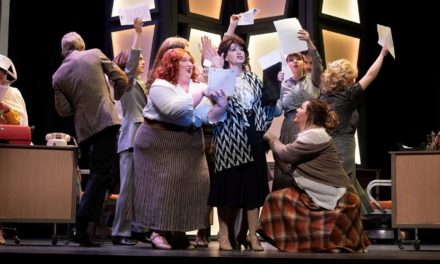CENTERVILLE — Irving Berlin’s popular movie White Christmas came out in 1954 and has become a staple part of many people’s holiday celebrations for generations. In 2008 the story was brought on stage on Broadway by David Ives and Paul Blake, with new songs that bring more characters to life. The story is about a pair of entertainers who had met in the Army during World War II. After returning home, they were able to make it big, touring with their show and making television performances. When a singing sister act secretly contacts them, through the guise of their older brother who had also served in the army, the veterans encounter a splash of love, Christmas spirit, and a desire to help an old army general in need. The show is a classic, with many popular and beloved songs, and a sweet, happy story line. Bringing such a classic to life can be challenging, because audiences will want to see that their favorite songs or elements are done well, while newcomers and strong critics may want to see something new and fresh. Centerpoint Legacy Theatre has done a fine job of producing a family friendly production that can enhance the holiday season.
The first thing that stands out in the production is the set designed by Ricky Parkinson. When the show opens on a Christmas performance in 1944 for the troops deployed to Europe. The set matched the somber mood that these soldiers would have been in at that time. The next scene brings takes place in 1954 on the Ed Sullivan Show, and this is where Parkinson really shined. From the cameras, to the set of the Ed Sullivan Show, to the screens on the sides of the theater where the action on the stage was projected in black and white, the set truly transformed the audience to what it must have been like to be behind the scenes of a TV show in the 195’0s. Throughout the show, the set was a strong technical element, indicating nightclubs, trains, the lodge where the main part of the action takes place, and more. The costume design team of Sandy Hunsaker and Sterling Hanks took obvious care to ensure that the costuming were appropriate to the time period, while also making sure to add the aesthetics necessary to keep the show visually appealing. The army uniforms were authentic, as were the dresses and the casual rehearsal clothing. During the large dance numbers, the costumes stood out as beautiful and pleasing, such as in “Blue Skies” and the final “White Christmas” number.
Headed by the four main leads, Ben Lowell as Bob Wallace, Jeremy Egan as Phil Davis, Madison Hanson as Betty Haynes, and Natalie Barnes as Judy Haynes, the CenterPoint White Christmas cast was unquestionably strong. These four performers had great chemistry, essential to the story of two sisters and two great friends and performers. During the popular number “Sisters,” Hanson and Barnes had beautiful harmonies that made it plausible to believe that they were siblings. Egan and Lowell presented their first number, “Happy Holiday,” so well that it was not hard to believe that this was a team that had been performing together for quite some time. As the show progressed, and the two pairs interacted with each other, the chemistry grew. During the touching song “Count Your Blessings Instead of Sheep,” Lowell and Haynes displayed a great deal of care and understanding, which lead me to have more empathy during the conflicts of the rest of the show.
Choreographer Kelley Richardson had a difficult job with the different genres of dance featured in the show, from ballroom to tap to traditional chorus dancing. Yet Richardson rose to the challenge, bringing excellent, memorable numbers, from the fun tap in “I Love a Piano,” to the great chorus choreography in “Blue Skies.” The cast excelled with all the large numbers, me thoroughly entertained.
As with most shows on opening night, some of the lines were missed, and some of the minor characters could use some fine-tuning with their entrances, most noticeable with the general played by Terrel Hebdon, and Martha, played by Meredith Gibson. However, Gibson gave a great performance and provided needed comic relief, especially with her number “Let Me Sing and I’m Happy.”
Overall, this is an excellent family show, something that young ages would enjoy with their parents and grandparents. Director Scott Montgomery has taken great care to make sure that the cast and crew developed an entertaining evening for all.






